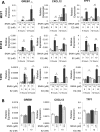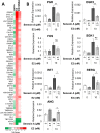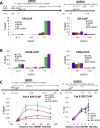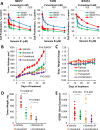Inhibition of CDK8 mediator kinase suppresses estrogen dependent transcription and the growth of estrogen receptor positive breast cancer
- PMID: 28147342
- PMCID: PMC5355036
- DOI: 10.18632/oncotarget.14894
Inhibition of CDK8 mediator kinase suppresses estrogen dependent transcription and the growth of estrogen receptor positive breast cancer
Abstract
Hormone therapy targeting estrogen receptor (ER) is the principal treatment for ER-positive breast cancers. However, many cancers develop resistance to hormone therapy while retaining ER expression. Identifying new druggable mediators of ER function can help to increase the efficacy of ER-targeting drugs. Cyclin-dependent kinase 8 (CDK8) is a Mediator complex-associated transcriptional regulator with oncogenic activities. Expression of CDK8, its paralog CDK19 and their binding partner Cyclin C are negative prognostic markers in breast cancer. Meta-analysis of transcriptome databases revealed an inverse correlation between CDK8 and ERα expression, suggesting that CDK8 could be functionally associated with ER. We have found that CDK8 inhibition by CDK8/19-selective small-molecule kinase inhibitors, by shRNA knockdown or by CRISPR/CAS9 knockout suppresses estrogen-induced transcription in ER-positive breast cancer cells; this effect was exerted downstream of ER. Estrogen addition stimulated the binding of CDK8 to the ER-responsive GREB1 gene promoter and CDK8/19 inhibition reduced estrogen-stimulated association of an elongation-competent phosphorylated form of RNA Polymerase II with GREB1. CDK8/19 inhibitors abrogated the mitogenic effect of estrogen on ER-positive cells and potentiated the growth-inhibitory effects of ER antagonist fulvestrant. Treatment of estrogen-deprived ER-positive breast cancer cells with CDK8/19 inhibitors strongly impeded the development of estrogen independence. In vivo treatment with a CDK8/19 inhibitor Senexin B suppressed tumor growth and augmented the effects of fulvestrant in ER-positive breast cancer xenografts. These results identify CDK8 as a novel downstream mediator of ER and suggest the utility of CDK8 inhibitors for ER-positive breast cancer therapy.
Keywords: CDK8; breast cancer; estrogen independence; estrogen receptor; transcription.
Conflict of interest statement
EVB is a consultant, MC is a contract PI and a consultant and IBR is the President of Senex Biotechnology, Inc.
Figures









Comment in
-
CDK8: a new breast cancer target.Oncotarget. 2017 Feb 28;8(9):14269-14270. doi: 10.18632/oncotarget.15354. Oncotarget. 2017. PMID: 28209918 Free PMC article. No abstract available.
Similar articles
-
Anterior gradient-2 plays a critical role in breast cancer cell growth and survival by modulating cyclin D1, estrogen receptor-alpha and survivin.Breast Cancer Res. 2010;12(3):R32. doi: 10.1186/bcr2586. Epub 2010 Jun 4. Breast Cancer Res. 2010. PMID: 20525379 Free PMC article.
-
Endocrine therapy resistance can be associated with high estrogen receptor alpha (ERalpha) expression and reduced ERalpha phosphorylation in breast cancer models.Endocr Relat Cancer. 2006 Dec;13(4):1121-33. doi: 10.1677/erc.1.01257. Endocr Relat Cancer. 2006. PMID: 17158758
-
AKT Antagonist AZD5363 Influences Estrogen Receptor Function in Endocrine-Resistant Breast Cancer and Synergizes with Fulvestrant (ICI182780) In Vivo.Mol Cancer Ther. 2015 Sep;14(9):2035-48. doi: 10.1158/1535-7163.MCT-15-0143. Epub 2015 Jun 26. Mol Cancer Ther. 2015. PMID: 26116361
-
Cyclin-Dependent Kinase 8: A New Hope in Targeted Cancer Therapy?J Med Chem. 2018 Jun 28;61(12):5073-5092. doi: 10.1021/acs.jmedchem.7b00901. Epub 2018 Jan 9. J Med Chem. 2018. PMID: 29266937 Review.
-
Expression of CDK8 and CDK8-interacting Genes as Potential Biomarkers in Breast Cancer.Curr Cancer Drug Targets. 2015;15(8):739-49. doi: 10.2174/156800961508151001105814. Curr Cancer Drug Targets. 2015. PMID: 26452386 Free PMC article. Review.
Cited by
-
Cyclin-Dependent Kinases 8 and 19 Regulate Host Cell Metabolism during Dengue Virus Serotype 2 Infection.Viruses. 2020 Jun 17;12(6):654. doi: 10.3390/v12060654. Viruses. 2020. PMID: 32560467 Free PMC article.
-
miR‑592 acts as an oncogene and promotes medullary thyroid cancer tumorigenesis by targeting cyclin‑dependent kinase 8.Mol Med Rep. 2020 Oct;22(4):3316-3326. doi: 10.3892/mmr.2020.11392. Epub 2020 Jul 30. Mol Med Rep. 2020. PMID: 32945439 Free PMC article.
-
Synergistic Cytotoxicity of Renieramycin M and Doxorubicin in MCF-7 Breast Cancer Cells.Mar Drugs. 2019 Sep 16;17(9):536. doi: 10.3390/md17090536. Mar Drugs. 2019. PMID: 31527453 Free PMC article.
-
Role of transcription-regulating kinase CDK8 in colon cancer metastasis.Oncotarget. 2019 Jan 18;10(6):622-623. doi: 10.18632/oncotarget.26593. eCollection 2019 Jan 18. Oncotarget. 2019. PMID: 30774756 Free PMC article. No abstract available.
-
Development of adaptive anoikis resistance promotes metastasis that can be overcome by CDK8/19 Mediator kinase inhibition.bioRxiv [Preprint]. 2023 Dec 6:2023.12.04.569970. doi: 10.1101/2023.12.04.569970. bioRxiv. 2023. PMID: 38106208 Free PMC article. Preprint.
References
-
- The American Cancer Society What are the key statistics about breast cancer? 2016
-
- Clark GM, Osborne CK, McGuire WL. Correlations between estrogen receptor, progesterone receptor, and patient characteristics in human breast cancer. Journal of Clinical Oncology. 1984;2:1102–1109. - PubMed
-
- Keen JC, Davidson NE. The biology of breast carcinoma. Cancer. 2003;97:825–833. - PubMed
-
- Lim E, Metzger-Filho O, Winer EP. The natural history of hormone receptor-positive breast cancer. Oncology (Williston Park, N.Y.) 2012;26:688–94. 696. - PubMed
-
- Tsai MJ, O'Malley BW. Molecular mechanisms of action of steroid/thyroid receptor superfamily members. Annual Review of Biochemistry. 1994;63:451–486. - PubMed
MeSH terms
Substances
Grants and funding
LinkOut - more resources
Full Text Sources
Other Literature Sources
Medical
Molecular Biology Databases
Research Materials
Miscellaneous

